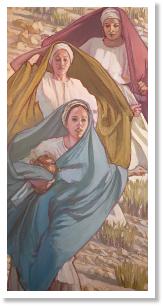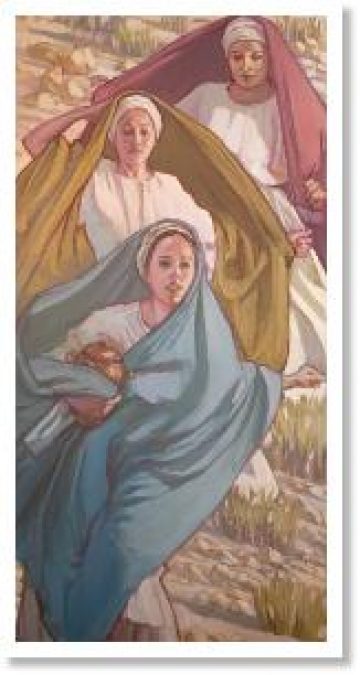 “Throughout His mortal ministry, the Savior showed special love and concern for women. In many parables, He told stories of women engaged in ordinary activities. He demonstrated deep familiarity with women’s lives.
“Throughout His mortal ministry, the Savior showed special love and concern for women. In many parables, He told stories of women engaged in ordinary activities. He demonstrated deep familiarity with women’s lives.
Women exercised faith in Jesus Christ, learned and lived His teachings. These women became exemplary disciples and important witnesses in the work of salvation.
Women journeyed with Jesus and His Twelve Apostles. They gave of their substance to assist in His ministry. After His death and Resurrection, women continued to be faithful disciples. They valiantly participated in the work of saving souls, temporally and spiritually.” (from Daughters in my Kingdom Chapter 1)
During this past week, my sister, Christanne, and I shared some scripture passages that we contemplated as Easter approached. One story that was meaningful to both us was the anointing of Jesus by Mary.
“Then Jesus six days before the passover came to Bethany, … There they made him a supper; and Martha served: …. Then took Mary a pound of ointment of spikenard, very costly, and anointed the feet of Jesus, and wiped his feet with her hair: and the house was filled with the odour of the ointment.” (John 12:1-3)
“[and she] poured it on his head. And … some that had indignation within themselves, … said, Why was this waste of the ointment made? For it might have been sold … and given to the poor. And Jesus said, Let her alone; why trouble ye her? she hath wrought a good work on me. …She hath done what she could: she is come aforehand to anoint my body to the burying.” (Mark 14:3-8)
My sister and I were both struck with the power of this anointing – by a woman. Not only did she give the Savior a great gift, but she understood what was happening. It appears she knew that Jesus would die and this anointing was a beautiful and powerful blessing – for what was shortly to come.
The story reminds me of another woman who understood and gave a gift – long before the resurrection on Easter morning – our mother, Eve.
“In Eden we will see all things created in a paradisiacal state – without death, without probationary experiences. We will come to know that such a creation, now unknown to man, was the only way to provide for the fall. We will then see Adam and Eve, the first and the first woman, step down from their state of immortal and paradisiacal glory to become the first mortal flesh on earth.” (from The Three Gardens of God, March 2016 Ensign, p 43)
Eve’s gift was to partake of the fruit, thereby “stepping down” from her paradisiacal state and ushering us all into mortality, which was our next step on our journey. I believe she too understood what was happening.
There were women at the cross and women at the tomb – and most famously, Mary Magdalene in the garden: the first witness to the resurrected Christ.
“Now when Jesus was risen early the first day of the week, he appeared first to Mary Magdalene” (Mark 16:9)
“But Mary stood without at the sepulchre weeping: … she turned herself back, and saw Jesus standing, and knew not that it was Jesus. Jesus saith unto her, Woman, why weepest thou? whom seekest thou? She, supposing him to be the gardener, saith unto him, Sir, if thou have borne him hence, tell me where thou hast laid him, and I will take him away. Jesus saith unto her, Mary. She turned herself, and saith unto him, Rabboni; which is to say, Master.” (John 20:11-16)
This scene inspires me with its tenderness and power. Mary came to understand that Jesus had done what He said He would: rise. She was then able to bear testimony to others.
I am also a woman of Easter. I love the Savior. I want to understand better the grace He offers me. I want to know my role and feel the power of the Holy Ghost.
“I was desirous also that I might see, and hear, and know of these things, by the power of the Holy Ghost, which is the gift of God to all who diligently seek him.” (1 Nephi 10:17)
May we know the hope of Easter and understand the power of the Master.
“Upon the handmaids .. will I pour out my Spirit” (Joel 2:29)
May it be so for me. And for us.






4 Responses
Beautiful. A perfect way to start my day of worship.
Beautiful post. Thank you! I’m sitting in the foyer at church reading this because I’m not getting any messages about Christ on this Easter Sunday, and what a treat to get a beautiful message about Christ and the wise and compassionate women he surrounded himself with.
So lovely. Especially this: “I am also a woman of Easter.” Thank you.
Beautiful, Suzette. I love your faith.